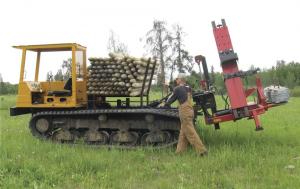2010 - Volume #34, Issue #4, Page #29
[ Sample Stories From This Issue | List of All Stories In This Issue | Print this story
| Read this issue]
Tracked Fencing Machine Works Fast In Rugged Terrain
 |
The Athabasca, Alta. man has operated a custom fencing business for about 5 yrs., pulling a rubber-tired post pounder behind a tractor. A big disadvantage of that method was that it got stuck in soft ground easily. His new system consists of a Morooka MST 800 Crawler Carrier, which has rubber tracks. Miller modified the unit for fencing purposes, investing a total of $45,000, including the $30,000 cost of the used crawler.
"This machine won't get stuck, even in places where an ATV would have trouble. It's also much easier to operate," Miller says. "I've found I can put in at least a third more posts by myself with this machine than 2 people can with a normal pull-behind pounder."
He removed the Morooka crawler's standard cargo box and mounted a home-built post-carrying rack on the frame behind the cab. This allows him to carry an 80-post bundle.
"I had a welder do some fabrication on the back of the Morooka so I could mount a 3-pt. pto-driven pounder using two pin pockets for it to pivot. The pounder is made by Wheatheart Manufacturing Ltd., out of Saskatoon, Sask.," Miller says. "If I ever want to, I can remove the pounder and put the crawler's box back on by taking out 4 pins and unhooking 2 hydraulic hoses."
Since the crawler is hydrostatic driven, Miller added a second hydraulic pump when he converted it to run the pounder. This enables him to lift the pounder up while driving to the next post and then let it down for pounding.
"The pounder has 2 different hydraulic rams -- one tilts and the other lifts, so it's always fairly level with the ground," he says.
"I modified the Morooka's steering linkages so I can run the machine and fence all alone," Miller explains. "I have steering arms in both the cab and at the rear of the machine, allowing me to drive the machine while walking beside it."
To include a wire roller/unroller feature on his rig, Miller welded a receiver hitch onto the pounder, and then mounted a Level-Wind Wire Spooler manufactured in Red Deer, Alta. He plumbed the unit's hydraulic motor into the pounder's system. Miller also mounted 3 arms to the back of the pounder so he can simultaneously lay down 3 wires.
The unroller's hitch makes it easy to move the post pounder to the tractor, if need be.
"The unroller and the post pounder need to be operated from the back of the crawler, where the levers are located," Miller says. "I usually pound along a pre-tensioned barb wire (set up with line posts). As I walk along, I pound the posts and unroll the wire at the same time. I have a marker (a rope with a colorful weight at the end of it) on the back that I drag behind, and when it hits the post that I just pounded, I know that it's time to stop and pound the next post. It's very efficient."
Because the unit has a solid track, Miller says "it doesn't have any bounce or slide when you start pounding, like the rubber-tired pounders do."
So far, he's used the rig on lots of soft ground, muskeg, and on steep side hills, with no problems. He can install about a 1/2-mile of fence per day or alternately, he can remove about a mile per day.
"After 2 months of use, I haven't found anything I'd like to change about it yet," he says.
Miller generally takes on custom fencing jobs within a 150-mi. radius of home and on average, charges about $3,000 (Can.) per mile for labor and equipment; materials are extra.
Contact: FARM SHOW Followup, Scott Miller, P. O. Box 1802, Athabasca, Alta., Canada T9S 2B5 (ph 780 675-7743; jen.miller@live.ca).

Click here to download page story appeared in.

Click here to read entire issue
To read the rest of this story, download this issue below or click here to register with your account number.




